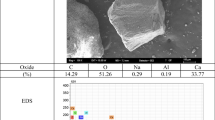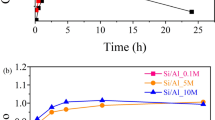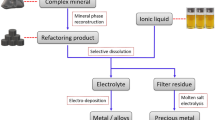Abstract
The leaching behavior of Tunceli smithsonite ore in nitric acid was evaluated in two study steps including optimization of leaching process and kinetics modeling. The individual and synergistic effects of effective parameters such as nitric acid concentration, solid-to-liquid ratio, stirring speed, and temperature on the dissolution rate of zinc were investigated using central composite design. Four factors including temperature (30–50 °C), nitric acid concentration (0.2–0.5 mol/L), stirring speed (350–600 rpm), and solid-to-liquid ratio (0.004–0.01 g/L) were investigated. The dissolution percent of zinc (97%) was obtained in 120 min of leaching time: acid concentration 0.5 mol/L, temperature 50 °C, stirring speed 500 rpm, and solid–liquid ratio 2/500 g/mL at the optimum conditions obtained using the central composite design. The dissolution kinetics of smithsonite was examined according to heterogenous models and it was found that the dissolution rate was controlled by ash layer diffusion process. It was found that the leaching rate increased with increasing temperature, stirring speed, and acid concentration as well as decrescent particle size and solid/liquid ratio. The trial data were analyzed by statistical and graphical methods and the activation energy of this leaching process was determined to be 28.63 kJ·mol−1.
Graphical Abstract










Similar content being viewed by others
References
Moghaddam J, Sarraf-Mamoory R, Yamini Y, Abdollahy M (2005) Determination of the optimum conditions for the leaching of nonsulfide zinc ores (high-SiO2) in ammonium carbonate media. Ind Eng Chem Res 44:8952–8958. https://doi.org/10.1021/ie050479+
Ejtemaei M, Gharabaghi M, Irannajad M (2014) A review of zinc oxide mineral beneficiation using flotation method. Adv Colloid Interface Sci 206:68–78. https://doi.org/10.1016/j.cis.2013.02.003
Abali Y, Bayca SU, Gumus R (2017) Dissolution kinetics of smithsonite in boric acid solutions. Physicochem Probl Miner Process 53:161–172. https://doi.org/10.5277/ppmp170113
Yang T, Rao S, Zhang D et al (2016) Ligand selection model for leaching of low grade zinc oxide ores. Characterization of minerals, metals, and materials 2016. Springer International Publishing, Cham, pp 327–335
Jha MM, Kumar V, Singh R (2001) Review of hydrometallurgical recovery of zinc from industrial wastes. Resour Conserv Recycl 33:1–22. https://doi.org/10.1016/S0921-3449(00)00095-1
Hurşit M, Laçin O, Saraç H (2009) Dissolution kinetics of smithsonite ore as an alternative zinc source with an organic leach reagent. J Taiwan Inst Chem Eng 40:6–12. https://doi.org/10.1016/j.jtice.2008.07.003
Ehsani I, Ucyildiz A, Obut A (2019) Leaching behaviour of zinc from a smithsonite ore in sodium hydroxide solutions. Physicochem Probl Miner Process 55:407–416. https://doi.org/10.5277/ppmp18150
Dhawan N, Safarzadeh MS, Birinci M (2011) Kinetics of hydrochloric acid leaching of smithsonite. Russ J Non-Ferrous Met 52:209–216. https://doi.org/10.3103/S1067821211030059
Laçin O, Dönmez B, Eti FE (2018) Investigation of leaching kinetics of smithsonite ore. Iran J Chem Chem Eng 37:205–212
Zhao Y, Stanforth R (2000) Production of Zn powder by alkaline treatment of smithsonite Zn–Pb ores. Hydrometallurgy 56:237–249. https://doi.org/10.1016/S0304-386X(00)00079-7
Talan D, Atalay MÜ, Altun NE (2017) Extraction of zinc from smithsonite by ammonia leaching. In: Proceedings of the 3rd World Congress on mechanical, chemical, and material engineering (MCM’17), pp. 1301–1306. https://doi.org/10.11159/mmme17.130
Feng Q, Wen S, Zhao W et al (2015) Dissolution regularities of smithsonite in methane sulfonic acid. Russ J Non-Ferrous Met 56:365–371. https://doi.org/10.3103/S1067821215040033
Wu D-D, Wen S-M, Yang J et al (2013) Dissolution kinetics of smithsonite in sulfamic acid solution. Asian J Chem 25:10556–10560. https://doi.org/10.14233/ajchem.2013.15944
Ju S, Motang T, Shenghai Y, Yingnian L (2005) Dissolution kinetics of smithsonite ore in ammonium chloride solution. Hydrometallurgy 80:67–74. https://doi.org/10.1016/j.hydromet.2005.07.003
Espiari S, Rashchi F, Sadrnezhaad SK (2006) Hydrometallurgical treatment of tailings with high zinc content. Hydrometallurgy 82:54–62. https://doi.org/10.1016/j.hydromet.2006.01.005
Zárate-Gutiérrez R, Lapidus GT, Morales RD (2010) Pressure leaching of a lead–zinc–silver concentrate with nitric acid at moderate temperatures between 130 and 170°C. Hydrometallurgy 104:8–13. https://doi.org/10.1016/j.hydromet.2010.04.001
Zhang W, Li J, Zhao Z (2015) Leaching kinetics of scheelite with nitric acid and phosphoric acid. Int J Refract Met Hard Mater 52:78–84. https://doi.org/10.1016/j.ijrmhm.2015.05.017
Santos SSG, Silva HRM, de Souza AG et al (2015) Acid-leached mixed vermiculites obtained by treatment with nitric acid. Appl Clay Sci 104:286–294. https://doi.org/10.1016/j.clay.2014.12.008
Habbache N, Alane N, Djerad S, Tifouti L (2009) Leaching of copper oxide with different acid solutions. Chem Eng J 152:503–508. https://doi.org/10.1016/j.cej.2009.05.020
Kirk RE, Othmer DF, Grayson M (1985) Kirk-Othmer concise encyclopedia of chemical technology, 4th edn. Wiley, New York
Madi-Azegagh K, Yahiaoui I, Boudrahem F et al (2018) Applied of central composite design for the optimization of removal yield of the ketoprofen (KTP) using electrocoagulation process. Sep Sci Technol. https://doi.org/10.1080/01496395.2018.1556298
Bezerra MA, Santelli RE, Oliveira EP et al (2008) Response surface methodology (RSM) as a tool for optimization in analytical chemistry. Talanta 76:965–977. https://doi.org/10.1016/j.talanta.2008.05.019
Jain M, Garg VK, Kadirvelu K (2011) Investigation of Cr(VI) adsorption onto chemically treated Helianthus annuus: optimization using response surface methodology. Bioresour Technol 102:600–605. https://doi.org/10.1016/j.biortech.2010.08.001
Mazaheri H, Ghaedi M, Asfaram A, Hajati S (2016) Performance of CuS nanoparticle loaded on activated carbon in the adsorption of methylene blue and bromophenol blue dyes in binary aqueous solutions: using ultrasound power and optimization by central composite design. J Mol Liq 219:667–676. https://doi.org/10.1016/j.molliq.2016.03.050
Kataria N, Garg VK (2018) Optimization of Pb (II) and Cd (II) adsorption onto ZnO nanoflowers using central composite design: isotherms and kinetics modelling. J Mol Liq 271:228–239. https://doi.org/10.1016/j.molliq.2018.08.135
Gunst RF, Myers RH, Montgomery DC (2006) Response surface methodology: process and product optimization using designed experiments. Technometrics 38:285. https://doi.org/10.2307/1270613
Ekmekyapar A, Aktaş E, Künkül A, Demirkiran N (2012) Investigation of leaching kinetics of copper from malachite ore in ammonium nitrate solutions. Metall Mater Trans B 43:764–772. https://doi.org/10.1007/s11663-012-9670-2
Garg UK, Kaur MP, Garg VK, Sud D (2008) Removal of nickel(II) from aqueous solution by adsorption on agricultural waste biomass using a response surface methodological approach. Bioresour Technol 99:1325–1331. https://doi.org/10.1016/j.biortech.2007.02.011
Hamsaveni D, Prapulla S, Divakar S (2001) Response surface methodological approach for the synthesis of isobutyl isobutyrate. Process Biochem 36:1103–1109. https://doi.org/10.1016/S0032-9592(01)00142-X
Zhang X, Li X, Cao H, Zhang Y (2010) Separation of copper, iron (III), zinc and nickel from nitrate solution by solvent extraction using LK-C2. Sep Purif Technol 70:306–313. https://doi.org/10.1016/j.seppur.2009.10.012
Hoh YC, Chou NP, Wang WK (1982) Extraction of zinc by LIX 34. Ind Eng Chem Process Des Dev 21:12–15. https://doi.org/10.1021/i200016a003
Adhikari CR, Narita H, Tanaka M (2012) Solvent extraction equilibrium of zinc from nitrate solutions with 2-ethylhexylphosphonic acid mono-2-ethylhexyl ester. Ind Eng Chem Res 51:16433–16437. https://doi.org/10.1021/ie301589s
Huynh HT, Tanaka M (2003) Removal of Bi, Cd Co, Cu, Fe, Ni, Pb, and Zn from an aqueous nitrate medium with Bis(2-ethylhexyl)phosphoric acid impregnated kapok fiber. Ind Eng Chem Res 42:4050–4054. https://doi.org/10.1021/ie020794l
Levenspiel O (1999) Chemical reaction engineering. Ind Eng Chem Res 38:4140–4143. https://doi.org/10.1021/ie990488g
Wen CY (1968) Noncatalytic heterogeneous solid-fluid reaction models. Ind Eng Chem 60:34–54. https://doi.org/10.1021/ie50705a007
Habashi F (1983) Dissolution of minerals and hydrometallurgical processes. Naturwissenschaften 70:403–411. https://doi.org/10.1007/BF01047177
Acknowledgements
This work was supported by Munzur University Scientific Investigations Project Unit (PPMUB018-13).
Author information
Authors and Affiliations
Corresponding author
Ethics declarations
Conflict of interest
All authors have declared no conflict of interest.
Additional information
The contributing editor for this article was Atsushi Shibayama.
Publisher's Note
Springer Nature remains neutral with regard to jurisdictional claims in published maps and institutional affiliations.
Rights and permissions
About this article
Cite this article
Tanaydın, M.K., Bakıcı Tanaydın, Z. & Demirkıran, N. Determination of Optimum Process Conditions by Central Composite Design Method and Examination of Leaching Kinetics of Smithsonite Ore Using Nitric Acid Solution. J. Sustain. Metall. 7, 178–191 (2021). https://doi.org/10.1007/s40831-020-00333-z
Received:
Accepted:
Published:
Issue Date:
DOI: https://doi.org/10.1007/s40831-020-00333-z




